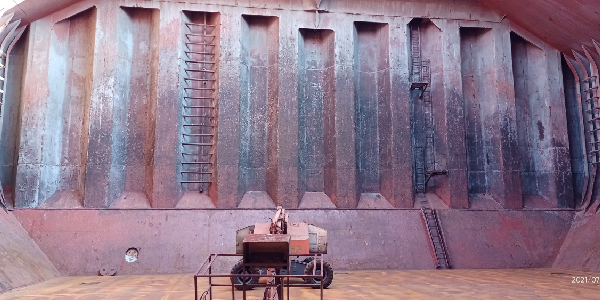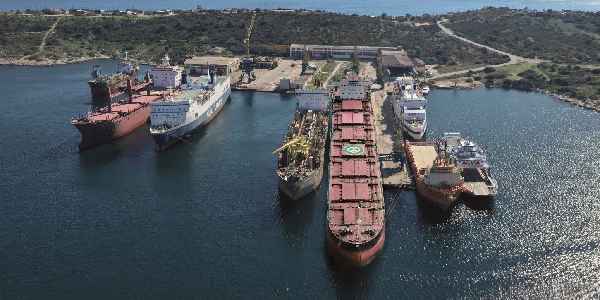Coating practices for cargo holds/tanks and ballast tanks vary depending on the purpose, type and sequence thereof. An erroneous choice of coating may result in failure and contamination of the surface as well as of the cargo/ballast carried therein. Cargo holds/tanks or ballast tanks are commonly used to store or transport a variety of substances that include petrochemicals, animal or vegetable oils, miscellaneous products, ale and water. Applying only best coating practices will combat harsh conditions and safeguard you from contaminating surfaces, cargoes, provided coating material formulas are designed to be chemically balanced, hygienic, with high resistance to abrasion and extreme temperature.
Choosing the Right Supplier for Coating Cargo Holds / Tanks & Ballast Tanks
In order to choose the right coating supplier, one must first understand the practices applied by well-known dockyards. For instance, take a look at Kynosoura Dockyard and how standardized coating and re-coating projects are delivered.
Kynosoura Dockyard, located on the eastern side of Salamis Island and only 3 miles off the port of Piraeus, has experienced specialists working on-board to provide the best coating and recoating methods for ships’ structures and holds/tanks. Kynosoura Dockyard undertakes a broad spectrum of specific applications like grit blasting up to SA 2.5 or high-pressure hydro blasting and painting to satisfy their customers. Kynosoura Dockyard takes great pride in meeting all requirements for delivery of cost-effective coating applications.
POINTS TO NOTE FOR COATING BALLAST TANKS
Coating of Ballast and Cargo Tanks should be repellent to seawater, corrosion, side effects of cathodic protection, cargo chemical or abrasion impact and so on. Corrosion damage is the main reason for putting a ship out of service and hence recoating should be done in such a way that it doesn’t affect the hull of the ship.
The inner water ballast tank area is large, so consider inspecting first before moving ahead with re-coating. Also, the double hull is designed to prevent oil leakage so your coating system must ensure protection at any cost. Due to the difficulties of re-coating complex steelwork, it is important to check these essential points. Recoating ballast tanks with light-colored and hard coatings fused with cathodic protection is important.
At Kynosoura Dockyard, rigorous techniques are followed while always keeping track of the latest tools and coating methods, according always to paint supplier specialists’ recommendations. The arrangement of the necessary access facilities (either Scaffolding or Cherry Picker) is also included in the scope of work undertaken by Kynosoura Dockyard. Preparation works for the proper coating application can be done either by grit blasting (up to SA 2.5) or hydro blasting (up to 2500 bar).
Pitting corrosion in tanks occurs because of coating irregularities, faulty coated areas, and mechanical damage. Often this is attributed to the presence of larger quantities of poor-grade steel material. To prevent corrosion from happening, install anodes (where allowed) along with your coating system. Here are some key points to follow:
- Re-coating can be applied over the shop primer upon thorough cleaning; you can also remove this by blasting when primed surfaces are not in good condition. To avoid getting osmotic blistering, consider having the soluble salt content on the surface to a minimum level. Tanks should be re-coated with an approved system.
- Re-coating should give a good edge coverage; hence it will lessen the need to round the edges. Strip-coating the sharp edges is always a good practice before you proceed with spray application for each coat.
- Your coating systems should provide barrier protection for corrosion.
- Conventional coating systems like bituminous coatings and solvent-free that require heating before applying are rarely used nowadays because modern systems use high solids coal tar epoxy.
POINTS TO NOTE FOR COATING CARGO HOLDS / TANKS
Coating systems for cargo holds/tanks should first check the type of cargo transported, what kind of substance it could release, what are the tank cleaning procedures and whether any cross-contamination takes place between the cargo and the ballast water. Below are pointing notes with regards to coating cargo holds/tanks:
- Should be free from pores, and corrosion-hindering and can be cleaned easily.
- Must take into consideration to not contaminate the color and taste of the substance in the cargo as this may be intended for consumption.
- Recoating systems are certified and checked by an appropriate regulatory agency.
Kynosoura Dockyard has a wide experience in coating and re-coating holds and tanks, delivering services to numerous vessels for over 50 years. With the help of experienced labor and specialized subcontractors, Kynosoura Dockyard provides a broad range of protection of metallic surfaces & tank coating application services, such as grit blasting and painting works, to satisfy all specifications provided by its customers. A Trustmark dockyard, we look forward to helping cargo or ballast tanks with coating applications that meet the requirements of any paint manufacturer, in the most cost-effective manner.




